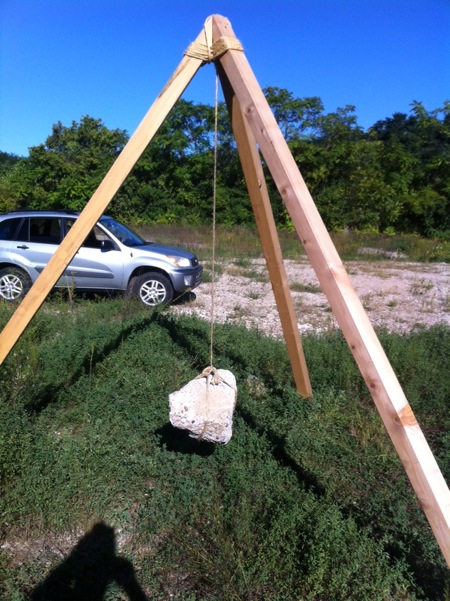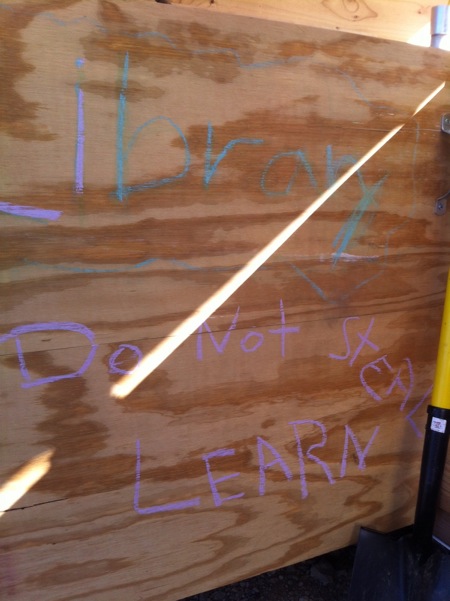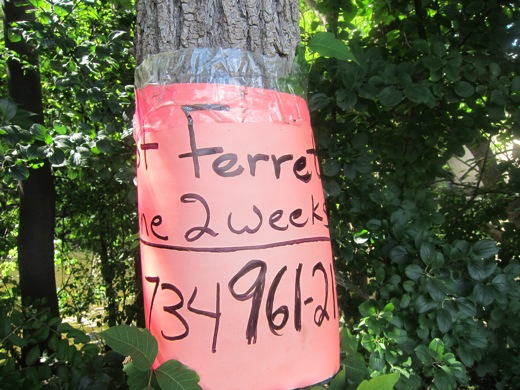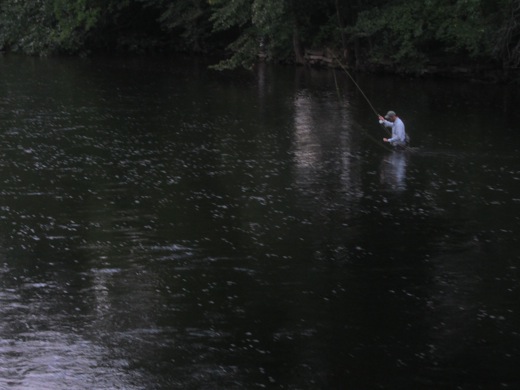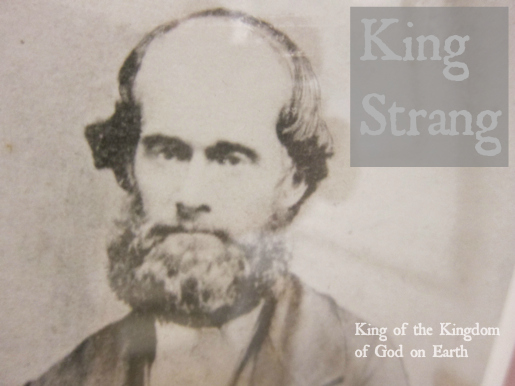
The fellow pictured above is James Jesse Strang, the self-proclaimed prophet who, upon the death of Joseph Smith on June 27, 1844, mounted a nearly successful attempt to wrench control of the Mormon church from Brigham Young. His presence continues to loom large over Michigan’s Beaver Island, where I spent this past weekend, and where he led his followers in 1848, and presided over them as “King” until his murder on July 9, 1856… a murder, by the way, which seems to have at least had the tacit approval of the U.S. government. (Strang, a two-term member of the Michigan House, was planning a Congressional run at the time of his death, and his growing prominence was clearly seen by many to be a threat. And, to make matters worse, he and his congregation also owned valuable property that others coveted. Oh, and then there was the fact that he was the leader of a cult that scared the living shit out of his contemporaries. When you put all the pieces together, it’s hard to imagine any result other than assassination.) Strang’s story, for reasons we’ll soon get into, is one of the most interesting that I’ve stumbled across since moving to Michigan, and I’m having a difficult time letting go of it, even though I’m now hundreds of miles removed from the site of his former kingdom.
My research thus far is still somewhat rudimentary. I interviewed Beaver Island historian Bill Cashman, and spent several hours digging through the collections of the local historical museum, which, by the way, is housed in what had once been Strang’s print shop. (Strang, when he wasn’t receiving prophecy, traveling in search of converts, taking on new wives, or shaking down local fisherman for financial tributes, edited the Daily Northern Islander, norther’s Michigan’s first newspaper.) Here’s what I know thus far.
THE EARLY YEARS
James Jesse Strang was born to a farming family in Scipio, New York on March 21, 1813. He was baptized at 12 as a Baptist. He was, by all accounts, a short man with a disproportionately large head and intense eyes. What he lacked in height, though, he more than made up for in ambition. Here are two excerpts from his diary. It should be noted that certain phrases contained below were originally written in code, and only deciphered generations later by Strang’s grandson, Mark Strang, a banker in Long Beach, California.

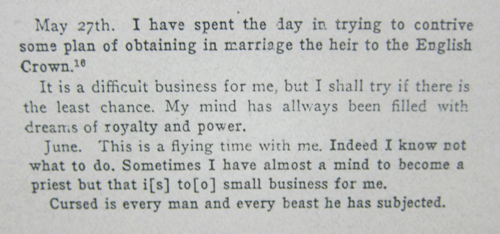
Clearly, farming wasn’t going to satisfy the young Strang. He took up law, and was admitted to the New York bar at age 23. Among other things, he served as Postmaster of his country, a newspaper editor, and a Baptist minister.
THE MORMON CONVERSION
Things began to change for Strang in 1843, according to author Robert Weeks, when Strang and his young wife, Mary Perce, chose to move to Burlington, Wisconsin with their infant child. It was there that the young lawyer had the occasion to attend a Mormon meeting featuring an Apostle of Joseph Smith’s known as “The Wild Ram of the Mountains.” Perhaps envious of the Wild Ram’s ability to move his audience to fits of religious ecstacy, Strang, shortly afterward, made the 200-mile trip to Nauvoo, Illinois to meet Joseph Smith, and join his movement. The following clip comes from Weeks’ book, “King Strang .”
.”
…Nauvoo seethed with political intrigue and violent anti-Mormon feeling. Clearly, the sect could not last much longer in Nauvoo. When Strang proposed to Joseph Smith and his brother Hyrum that he found a Mormon colony near Burlington, Wisconsin, they promptly made him an elder of the church and urged him to report on the possibilities to the north…
Beaver Island historian Bill Cashman used the phrase “business value” when discussing Strang’s conversion to Mormonism. “Strang saw the business value of the religion,” he said. He knew that, with his charisma and drive, he could draw crowds and build a following. And he liked the lifestyle embodied by Joseph Smith. He too wanted to go east and proselytize in the spring. And, in the fall, come back and live off the labor of his followers. And that’s what he did. He was baptized by Smith on February 25, 1844, and, on March 3, he traveled back to Wisconsin to establish the Moron community at Voree… To put it in modern parlance, he essentially bought a franchise.
THE FIGHT FOR THE CHURCH
Joseph Smith wouldn’t live to see Voree. He was murdered by an anti-Mormon mob in Carthage, Illinois on June 27. And, in his absence, a struggle for control took shape, with the relative newcomer, Strang, taking on Brigham Young. The following, again, comes from Weeks.
…At the precise moment when a rifle ball struck Smith causing him to fall to his death out of the second story window of the Carthage jail, Strang was taking a solitary walk through the countryside outside Burlington. As the Prophet’s life was extinguished, Strang said later, he heard celestial music, looked into the sky, and saw an angel accompanied by a heavenly host glide down onto the meadow in which he stood. The angel stretched forth a hand anointing Strang’s head with oil as a sign that henceforth Prophet Strang was to be the supreme ruler of the Saints on earth…
And, according to Strang, this same vision of him as supreme ruler was shared by Smith, who mailed him a letter several days before he died, essentially handing over the church to his care. “The wolves are upon the scent and I am waiting to be offered up if such be the will of God,” said Smith in the letter. God came to him in a vision, he said, and told of Strang’s role going forward. “I bowed my head to the earth and asked only wisdom and strength for the church. The voice of God answered… My servant Joseph thou hast been faithful… Now behold my servant James J. Strang hath come to thee from far for truth when he knew it not and hath not rejected it, but had faith in thee, the shepherd and stone of Israel, and to him shall the gathering of the people be, for he shall plant a stake of Zion in Wisconsin and I will establish it, and there shall my people have peace and rest and shall not be moved in the lands of Racine and Walworth. I will have a house built unto me there of stone…” Brigham Young, as you might expect, dismissed the letter, calling it “a wicked forgery” produced by a “base liar.” (From what I’ve read, most scholars these days seem to think the letter, which is commonly referred to as The Letter of Appointment, was not forged, but really was penned by Smith.)
And, with that, the battle between the two men over the future of the religion began in earnest. Not only did three of Smith’s 12 Apostles support Strang, but so too did Smith’s mother and brother William. And, with their support, and that of a number of individuals excommunicated by Young, Strang set out on a two-pronged attack. First, he traveled the country making the case that the religion deserved to have another true prophet at its head. (Young was a leader, but not a prophet, as I understand it.) And, second, he aggressively made the case that Mormonism should divorce itself completely from the practice of polygamy, the fruits of which, as we all know, were much enjoyed by Brigham Young and his faction.
At this point it’s probably worth noting that Strang didn’t really live up to the second plank of his platform. At the time of his death, in spite of the fact that he started out as an ardent anti-polygamy crusader, he had five wives. (Three of these young wives were pregnant at the time of his death.) Everything apparently changed when he met Elvira Eliza Field, whom he married in a secret ceremony in 1849. For the better part of a year, Strang was able to pass her off as his fictional nephew, “Charlie J. Douglas,” but, in 1850, he came clean with his followers, sharing the fact that Charlie was a woman, and that that he was actively taking ‘plural wives’. Three more wives would follow soon afterward.
Here, according to Wikipedia, is how Strang framed his reversal on polygamy.
…Strang defended his new tenet by claiming that, far from enslaving or demeaning women, polygamy would liberate and “elevate” them by allowing them to choose the best possible mate based upon any factors deemed important to them—even if that mate were already married to someone else. Rather than being forced to wed “corrupt and degraded sires” due to the scarcity of more suitable men, a woman could marry the man she saw as the most compatible to herself, the best candidate to father her children and give her the finest possible life, no matter how many other wives he might have…
It was, you see, all about democracy, and not at all in conflict with the American way of life.
Strang lost some followers as a result of this decision, but it doesn’t look as though his position was in any way diminished. New followers kept coming, and he was elected into the Michigan legislature.
THE REVELATION
As I stated above, Strang had made a decision to market himself as the inheritor of Smith’s prophetic visions, and, toward that end, he began making claims shortly after Smith’s death that he too had been guided to hidden tablets by angels. Here, with more on that, is a clip from The Society for Strang Studies about what have come to be known as the Voree plates.
…As had Joseph Smith before him, Strang claimed to be blessed by heavenly visions, and claimed that an angel had appeared before him, revealing the location of an account of an ancient people, buried in a hill south of White River bridge.
After publicly revealing this vision to his followers on September 13, 1845, four of his most trusted elders accompanied him to a location beneath an oak tree deep in the woods, at which point Strang informed them that it was the spot beneath which the secret was buried. The four men later reported that “the tree was surrounded by a sward of deeply rooted grass, such as is usually found in the openings, and upon the most critical examination we could not discover any indication that it had ever been cut through or disturbed.”
Proceeding to dig, eventually discovering an earthenware case, the witnesses further reported “We examined as we dug all the way with the utmost care. We say, with utmost confidence that no part of the earth through which we dug exhibited any sign or indication that it had been moved or disturbed at any time previous. The roots of the tree stuck down on every side very closely, extending below the case, and closely interwoven with roots from other trees. None of them had been broken or cut away. No clay is found in the country like that of which the case is made.”
Opening the clay case, it was found to contain six mysterious brass plates, which were taken as being of divine origin.
This revelation sealed Strang’s status as a “Prophet and a Seer of God” in the eyes of his followers, and their zealous dedication to their leader increased immeasurably. When the influx of gentile (non-Mormon) settlers into the Voree area threatened to disrupt their lifestyle, Strang set-out to identify a safe refuge for his flock.
Arriving in Northern Michigan, Strang began to search in the Charlevoix area, eventually identifying Beaver Island with its secluded harbor, lush forests and abundant fishing as “where I will come to build up my kingdom”…
Here are drawings of the plates, which have apparently been missing since 1900.

Of course, as you may have guessed, the plates have been thought to be forgeries from the very beginning. The following is from Wikipedia.
…Isaac Scott, an ex-Strangite, claimed that Caleb Barnes, Strang’s former law partner, said that he and Strang had fabricated them from a tea kettle belonging to Strang’s father-in-law, as part of a land speculation scheme they had hatched.
According to Scott, Barnes and Strang “made the ‘plates’ out of Ben [Perce]’s old kettle and engraved them with an old saw file, and… when completed they put acid on them to corrode them and give them an ancient appearance; and that to deposit them under the tree, where they were found, they took a large auger…which Ben [Perce] owned, put a fork handle on the auger and with it bored a long slanting hole under a tree on ‘The Hill of Promise,’ as they called it, laying the earth in a trail on a cloth as taken out, then put the ‘plates’ in, tamping in all the earth again, leaving no trace of their work visible”…
It’s like something right out of Huckleberry Finn , isn’t it?
, isn’t it?
THE MOVE TO BEAVER ISLAND
The following comes from the website of the Strangite sect of Mormonism, which still exists today in Wisconsin. (It would seem that they now just number a few hundred.)
…In barely a year, (Strang) had already duplicated Joseph Smith’s style when he announced that he discovered an ancient American record inscribed on brass tablets in a Wisconsin hillside. Before long, he was issuing thousands of tracts and newspapers from his press in Wisconsin, and had gathered together several thousand members to his church. Brigham Young ignored Strang’s affirmations, and took a separate group to near Council Bluffs, Iowa, and eventually to Utah in 1847. In the same year, Strang claimed to have a vision that the gathering place of God’s faithful was instead to be in Michigan, on the Beaver Island archipelago. Land ownership disputes broke out with non-Mormons in the area, as well as jealousies over economic prosperity with neighboring Mackinac. Strang developed the city of Saint James, the best sheltered harbor on Lake Michigan, and established a steamboat wood trade and salted fish export industry…
IT’S GOOD TO BE THE KING
From the Beaver Island Historical Society:
…Strang formed a colony on Beaver Island in 1848. It grew year by year, and soon had the numbers to elect Strang to the state legislature. Trouble with the “gentiles” led to the “War of Whiskey Point”, which the Mormons won by firing a canon at the unruly gang gathered at the trading post. By the early 1850s, most of the non-Mormons had left the Island. The ensuing degree of absolute power went to Strang’s head, and rumors spread about Mormon attrocities. Strang had himself crowned king, and began taking additional wives…
More from The Society for Strang Studies:
…On July 8, 1850 Strang proclaimed himself to be “King of the Kingdom of God on Earth,” before two hundred and thirty five of his followers. While claiming to be King only of his followers, he began extracting tithes from the gentiles, consisting largely of fishermen who called the island home long before the Strangites arrival. Refusing to pay, it was rumored that Strang had many of the fishermen taken into the woods and flogged, in the hope of opening-up their purse strings. Strang then ordered the County Treasurer to hand-over one tenth of the taxes collected on the island, a move that once again met with a wholly negative reception by the island’s “gentile” population.
Strang erected a large log temple, owned a commercial boat and saw mill, which was used to saw lumber for housing for the island’s growing Mormon population. Strang then founded a newspaper “The Northern Islander,” and published books and pamphlets defending his right of Divine rule.
Friction continued to increase between gentile and Mormon, fueled by Strang’s suffocation of the whiskey trade in the area, and his sudden open embracing of polygamy as a “Divine requirement” of his followers. Many scuffles broke-out between the two factions, leading to the “War of Whiskey Point,” won by Strang’s followers when they fired a cannon into an unruly gang of rebels assembled at the trading post. As a result of such altercations, by the early 1850’s most of the gentile population on Beaver Island abandoned their homes for new lives on the mainland.
Mandating a requirement that all Church elders take at least two wives, Strang did his religious duty by marrying his third wife in 1852, and his fourth and fifth in 1855. All-told, Strang fathered twelve children from these five women. In spite of the divine imperative, no more than twenty of the island’s Mormon men were known to have actually practiced polygamy.
Strang’s control of his disciples began to widen beyond matters spiritual. Many consider his edict that women begin wearing bloomers, as opposed to the customary long skirts of the time, to have been a major component in the resentment that led to his eventual downfall.
By 1851 Strang and his entourage managed to hold all the political offices on nearby Mackinac Island, to which Beaver Island and its neighboring islands were attached for judicial and elective purposes. However, the continuing unrest between the gentiles and Mormons on the island, combined with Strang’s unconventional religious practices was not going unnoticed…
THE FINAL ACT
From the Society for Strang Studies:
…The Michigan “Mormon trouble” eventually reached President Millard Fillmore himself. Fillmore instructed the Attorney General to issue orders to the U.S. district attorney of Michigan to begin prosecution of Strang for offenses punishable in the federal court. Some of the Federal charges being delaying the mail, cutting timber from pubic lands, tax irregularities and counterfeiting.
The US Naval gunboat “Michigan” was immediately dispatched to Beaver Island. Onboard, a US Marshall, Deputies and the District Attorney with highest level orders to deliver Strang and his followers to stand trial the Federal Court in Detroit. Though some subterfuge, almost one hundred of Strang’s followers were lured to the ship, arriving in Detroit in May of 1851.
The trial was set for the next month, and a deal was struck to allow the release of all defendants on bail. The Deputy Clerk of the Court was instructed to travel to Beaver Island to depose all witnesses. The trial ran from June 20th through July 10th. Strang drawing on his past experience served as his own defense attorney.
It would appear that he did an admirable job, as against all expectation he won the case, and in victory he led his followers back to his Beaver Island Kingdom. The astounding court victory further sealed his power-base, and Strang was elected to the State legislature.
In 1856, David Brown reportedly found his wife in bed with his business partner, Thomas Bedford. A group of Mormon men seized Bedford and administered immediate justice through the administration of seventy-nine lashes across Bedford’s back.
As a result of his treatment, a strong resentment grew within Bedford for Strang and his teachings. It would appear that Bedford was not the only member of the community to have misgivings concerning Strang’s leadership, as Bedford and a group of 40 other men ambushed Strang on June 16, 1856, mortally wounding the King. The wounded Strang, along with most of his followers, set sail for Voree two days later, where Strang passed away a month later on July 8 – King’s Day.
On Strang’s death, most of the Irish fishermen who had lived on Beaver Island prior to Strang’s arrival, returned home. In fact, they found the island an improved place, since under Strang’s “rule,” significant improvements in cultivation, roads and housing had been made, transforming a large area of the island from wilderness to a civilized outpost…
It doesn’t mention it here, but the two men who delivered the fatal shots, after doing so, ran aboard the USS Michigan, and were transported to safety. They eventually received mock trials on Mackinac Island, were fined $1.25, and released… As for King Strang’s other followers leaving the island, that certainly happened, but I’m told it wasn’t of their own volition. As I understand it, they were given 24 hours to get onboard ships and leave the Island. The alternative, they were told, would be to burn to death inside their homes. Some of the Strangites renounced their religion, and were allowed to stay. All the others, and there were some 2,600 of them, chose to hand their possessions over to the mob and leave the island… In spite of all of this, though, the sect continues in Voree, Wisconsin, with a congregation of approximately 200, none of whom, as I understand it, are related to Strang.

